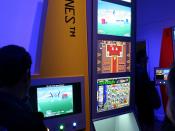The games console industry has been selected as exemplifying a relatively mature industry currently in a state of competitive flux. This industry traditionally renews itself every 5-6 years, as new technology advances make the previously impossible industry standard. Console gaming borne from arcade phenomenon which swept the globe throughout the 70s, promised the possibility of playing arcade-style games in home comfort. Advances in technology, in many cases, removed the need for arcade centres, a declining industry in recent years.
Not content with simply providing a home arcade system, the current consoles crop attempts to go further by creating home entertainment systems that not only play games, but on the internet utilising high-speed broadband connections, DVD movies and audio CDs to a high standard.
Repositioning consoles as home entertainment systems has seen the industry grow from humble beginnings to one bringing in global revenues over $20bn in 2002, well in excess of the Hollywood movie industry.
However, this assignment demonstrates the economic structures of the industry and firms within it have faced a number of challenges, and not all firms have proven successful.
Industry Players
Concentrating on the fortunes of 4 companies, each with unique strategies; motivations for entering the console industry, and each offering products appealing to different segments of the gaming market. Photos of the consoles can be found in Appendix A. The firms/consoles are :
* çÂÂçÂÂçÂÂçÂÂSony (Playstation 2)
* çÂÂçÂÂçÂÂçÂÂNintendo (Gamecube)
* çÂÂçÂÂçÂÂçÂÂMicrosoft (Xbox)
* çÂÂçÂÂçÂÂçÂÂSega (Dreamcast) (now defunct)
Competition Analysis
The industry conforms to an oligopolistic model of competition, currently being fought by three firms. The firms tend not to compete directly on price (discussed later) and a price cut by one firm usually results in a comparable cut by other firms. Competition is fought primarily on marketing strategies and software availability including other accessories. Additionally,



Great
Good statistics. Should provide sources though.
2 out of 2 people found this comment useful.